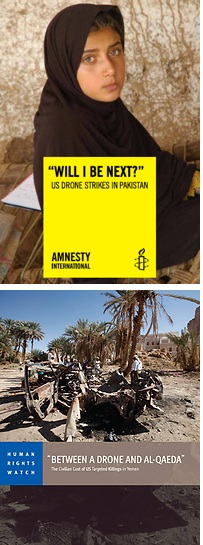‘Where has the media been, and why aren’t journalists also doing this kind of reporting in an effort to hold the government accountable for its top-secret drone program?’
Posted from Washington, Oct. 30, 2013

Two of the most credible advocacy organizations have just raised the stakes considerably in the drone wars controversy, contending that American airstrikes in Pakistan and Yemen have killed and injured many more innocent civilians than the U.S. government has acknowledged.
And Amnesty International and Human Rights Watch go even further in their respective reports (read them here and here), alleging that many of the attacks may have been illegal, and perhaps even war crimes.
 In some cases, they contend, the US drone strikes and other airstrikes killed many suspected militants when capturing them was a feasible option, or when it wasn’t clear if civilians could be killed along with them. The result: women, children and even a 68-year-old grandmother gathering vegetables in the family fields were killed by powerful missiles fired from pilotless aircraft.
In some cases, they contend, the US drone strikes and other airstrikes killed many suspected militants when capturing them was a feasible option, or when it wasn’t clear if civilians could be killed along with them. The result: women, children and even a 68-year-old grandmother gathering vegetables in the family fields were killed by powerful missiles fired from pilotless aircraft.
Here’s my most pressing question after reading the excellent reports: where has the media been, and why aren’t journalists also doing this kind of reporting in an effort to hold the government accountable for its top-secret drone program?
In their defense, some have tackled the story with varying levels of perseverance and success. But the reports by the two advocacy groups raise important questions that the media should be raising. So far, however, I haven’t seen much in the way of coverage, or follow-up. And that is deeply troubling.
The reports are worth reading in their entirety. But to summarize, Amnesty International did thorough, on-the-ground investigations of nine drone strikes in Pakistan in its “Will I Be Next?” report, interviewing witnesses and others. In its report, titled “Between a Drone and Al-Qaeda,” Human Rights Watch did essentially the same thing with six strikes in Yemen.
In all, Amnesty counted 29 people believed to be noncombatants as being killed in strikes in Pakistan, based on its investigation. According to its own probe, Human Rights Watch counted 57 civilian deaths in six strikes in Yemen, all but 16 of them in one deadly cruise missile attack in December 2009. (Most, but not all, of the strikes involved missiles fired from Predators and other drones).
According to media reports, the CIA had no comment and the White House had little to say, except that President Obama has already established more restrictive rules of engagement that have made it harder to kill civilians. Those new rules were announced in May, before most of the strikes examined in the reports.
US officials have insisted—before and after Obama’s speech—that the drone strikes are not only legal and necessary, but that they’re done with such precision as to virtually rule out civilian deaths.
The law is murky, at best, especially when the facts supporting their decisions are withheld because the information is classified. That too is troubling.
Perhaps Letta Tayler of Human Rights Watch put it best when she told a reporter that: “The U.S. should explain who it’s killing and why it’s killing them. We strongly suspect that their definition of ‘combatant’ is elastic and that they are stretching it beyond what international law allows.”
Hopefully the reports will spur the media to dig more deeply into this important story, and work harder to obtain the same kind of “ground truth” that the two organizations claim to have obtained—an objective and accurate assessment of the type and number of victims that refutes the official version emanating from Washington.
Reporters could start with some of the cases cited by Amnesty and Human Rights Watch, including a July 2012 series of drone strikes that killed 18 male laborers, including at least one boy; some of them died as they gathered in a tent for an evening meal, others when they came to help the wounded.
One of the most jarring cases was the October 2012 death of 68-year-old Mamana Bibi in Ghundi Kala village, northwest Pakistan. In its report, Amnesty says she was killed in a drone strike that appears to have been aimed directly at her. Her grandchildren told Amnesty investigators that they watched as she was literally blown to pieces before their eyes. They also say they have never received any kind of acknowledgment that it was a US drone that killed her, no less any kind of compensation or justice for her death.
Amnesty and Human Rights Watch said their investigations were hampered by the fact that the Obama administration refuses to provide even the most basic information about the strikes, including the justification for launching them.
As a result, “Amnesty International is unable to reach firm conclusions about the context in which the US drone attacks on Mamana Bibi and on the 18 laborers took place, and therefore their status under international law. However, based on its review of incidents over the last two years, Amnesty International is seriously concerned that these and other strikes have resulted in unlawful killings that may constitute extrajudicial executions or war crimes.’’
These are serious allegations. But Amnesty seems to have some justification in making them. Now it’s the media’s turn to see whose version of the truth is more accurate.
Josh Meyer is director of education and outreach for the Medill National Security Journalism Initiative. He spent 20 years with the Los Angeles Times before joining Medill in 2010, where he is also the McCormick Lecturer in National Security Studies. Josh is the co-author of the 2012 best-seller “The Hunt For KSM; Inside the Pursuit and Takedown of the Real 9/11 Mastermind, Khalid Sheikh Mohammed,’’ and a member of the board of directors of Investigative Reporters and Editors.





